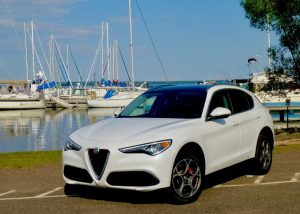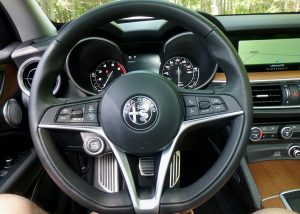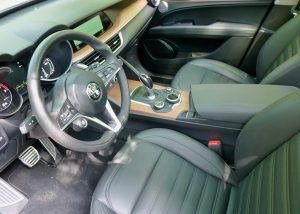Alfa Romeo Stelvio is SUV for S-curves
By John Gilbert
You may have never seen an Alfa Romeo Giulia sedan in the flesh. And you probably have never even heard of the Alfa Romeo Stelvio, an all-new and surprising crossover SUV built by Alfa Romeo and based on the Giulia.
For more than six months, I’ve been focused on relaying the wonders of the Giulia, once I get one for a week-long test drive, and a brief test drive in two of them at the Midwest Auto Media Spring Rally at Elkhart Lake, Wis., only caused my anticipation to rise higher. Because it’s still baseball season, we can go for the next best thing, accepting the Stelvio as a worthy pinch-hitter.
The 2018 Stelvio arrived, a glistening Trofeo White Tri-Coat vehicle. and it was intriguing enough that I tried to spend as much of the week as possible driving around the Duluth, Mn., and Western Lake Superior region.
Close to seductive in its overall demeanor, the Stelvio offers further evidence that somehow, every time Italians design a car we can guarantee it will exude emotion, and now we must expand that to include SUVs, especially the Stelvio, which Alfa calls “the SUV for S-Curves.”
My wife, Joan, and I drove the Stelvio Ti to the Spirit Valley Days car show in West Duluth, where I parked just beyond the lines of over 150 classic and restored vintage cars and hot rods, creating an unfair attraction of its own. Next, we drove down to Glensheen Mansion, where the midweek free summer concerts on the shoreline of Lake Superior are a highlight. And we capped the week by driving from Duluth to Bayfield, Wis., where we attended the Ricky Skaggs concert at Big Top Chautauqua, one of the classic tent-show venues in the country.
We knew Ricky Skaggs was an outstanding musician, but we were not prepared for the tremendous showmanship he and his group put on for a couple of hours under the Big Top. We also got the chance to meet him, and when he said he had played for a time with Emmylou Harris and her original “Hot Band,” I was able to solve a 30-year mystery about the identity of the fabulous guitar player on original masterpieces such as “Luxury Liner.” He said it was Albert Lea, a brilliant guitarist from England.
With a half-tank of premium still on board, we drove the 100 miles back to Duluth afterward and were pleasantly surprised to find we still had a quarter of a tank remaining. With EPA estimates of 22 city and 28 highway, we obviously exceeded the highway number on the trip. although I could not solve the mysterious computer to find any gas-mileage numbers. Another Italian thing, I figure.
I had seen the Stelvio at the Chicago Auto Show, and I came away figuring it was a Giulia on steroids, because it shared the same oval signature grille and slick lines and contours sweeping back over the passenger compartment. Turns out, the Stelvio is far different — a very interesting experiment in Alfa building something beyond its previous expertise in sporty sedans and sports cars.
It is filled with features, jammed into the Stelvio’s sleek outer shell, and none of which interrupt the constant emphasis on emotion and passion, assets that always identify anything wearing the Alfa Romeo name.
The name “Stelvio” comes from the Stelvio Pass, a legendary drive route high in the Italian Alps that some say is the best driving road in the wrold. I’ve driven over the Italian Alps a couple of times, and while I don’t recall the Stelvio Pass. I do vividly recall the wonderfully intricate turns and curves up and down those high-altitude regions. All of them were designed as though everybody who would drive on those roads would be driving a sports car. Or should be.
If they’d had a Stelvio in those days they could have saved a lot of investment on roadways and just sent folks hurtling up and down the Sound-of-Music-like meadows of an Alp or two. The Stelvio Ti we drove for a week was, undoubtedly, the first one in the state of Minnesota, just introduced as a 2018 model, and passers-by gawked at it everywhere we drove or parked.
I got an early chance with the car because of a weird chain of coincidences. In over four decades of reviewing the newest cars, I have never awaited a car as enthusiastically as the 2017 Alfa Romeo Giulia, the mainstream luxury-sports sedan that would lead Alfa Romeo back into the American market. A chance to go to Milano, Italy, for the unveiling further whetted my appetite.
But after the Giulia had been driven from Chicago to Duluth for me, glitch with the check-engine light led to flat-bedding it back to Chicago without me even seeing it! Because of all the Midwestern journalists awaiting the Giulia, I was relegated to the end of the list, and I literally counted the weeks for two or three months until its scheduled date of July 23. Three days before delivery, I learned Fiat-Chrysler had recalled the Giulias from press fleets for a software fix on the pre-production models.
Fortunately, a little sympathy from a couple of good people at Fiat-Chrysler help get me assigned to a first chance at the new Stelvio just sent to the press fleet headquarters.
The Stelvio comes in three forms, with the top being the Quadrifoglio, with an extremely potent twin-turbo V6 engine. My test drive was the mid-range Stelvio Ti Lusso, equipped with the responsive new 2.0-liter direct-injected and turbocharged 4-cylinder, which also powers the base Stelvio. It has 280 horsepower at 5,200 RPMs and 306 foot-pounds of torque at a peak that stays in a flattened arc from 2,000 to 4,500 RPMs.
The 8-speed ZF automatic transmission shifts smoothly up and down in milliseconds. A knob on the light walnut console has three settings — “a” for best economy, “n” for firmer suspension and tighter steering, and “d” for dynamic, which heightens steering control, suspension firmness and engine power. I remain unsure of how “a” and “n” translate, but “d” for dynamic not only makes sense, but I found that the engine, transmission, all-wheel drive, suspension, big wheels, and body were best coordinated when it was in d. Another Alfa tradition.
Built at Alfa’s Cassino plant in Frosinone, Italy, the Stelvio engines are both right out of the Giulia.Fiat, now Fiat-Chrysler, owns Alfa Romeo, as well as Ferrari, and Lancia. Each retains its own style and personality, and all wear their emotion on their fenders. Fiat dispatched Ferrari engineers to create the specific high-tech engines for the Giulia/Stelvio venture, and among the corporate high-tech features, the engines also use Fiat’s MultiAir2 system ofhydraulic intake valve actuation off the exhaust valves. So in a way Stelvio is a Giulia on steroids.
Double-wishbone suspension up front and rear “Alfa link” with a vertical stabilizing bar make the Stelvio Ti handle superbly on curvy roads and stay flat and stable in all conditions.
The preponderance for light walnut with raised grain on the console, dash and doors, blended with black leather seats and trim, makes the inside of the Stelvio Ti an easy place to appreciate the “mechanics of emotion.” Supportive bucket seats are adjustable every which way via power switches, and room for three more in the back, on fold-down seats that expand the large cargo area under the hatch, make the Stelvio meet all the requirements of an SUV.
Every manufacturer wants to build an SUV and capitalize on what has now become a world-wide craze. A luxury car company such as Jaguar has Land Rover as a partner to share engines and SUV tricks, but unless Alfa Romeo consulted with Jeep engineers, it had to go it alone to build its first SUV. The result worked.
From a base price of $46,495, some options carry stiff prices, such as the paint job, the oversized 8.8-inch display screen, the huge sunroof, the Harmon Kardon audio upgrade to 900 watts through 12 channels to 14 speakers, among others. And yet the splendid leather and wood interior is standard equipment on the Ti.
As tested, the Stelvio Ti comes in at $56,000. That includes 235/55 Continental M+S tires on 19 inch wheels, adding to the handling stability. With the turbo 4, the Stelvio Ti goes 0-60 in just under 6 seconds, reportedly about two seconds slower than the twin-turbo V6 model.
We aren’t kidding anyone by comparing the new Stelvio Ti Lusso with the lower, lighter and sleeker Giulia sedan’s handling, but it’s a lot more fair to compare the Stelvio with any and all luxury-sport SUVs, which would lead to the inescapable conclusion that Alfa has indeed made the Stelvio the SUV for S-Curves.









 John Gilbert is a lifetime Minnesotan and career journalist, specializing in cars and sports during and since spending 30 years at the Minneapolis Tribune, now the Star Tribune. More recently, he has continued translating the high-tech world of autos and sharing his passionate insights as a freelance writer/photographer/broadcaster. A member of the prestigious North American Car and Truck of the Year jury since 1993. John can be heard Monday-Friday from 9-11am on 610 KDAL(www.kdal610.com) on the "John Gilbert Show," and writes a column in the Duluth Reader.
John Gilbert is a lifetime Minnesotan and career journalist, specializing in cars and sports during and since spending 30 years at the Minneapolis Tribune, now the Star Tribune. More recently, he has continued translating the high-tech world of autos and sharing his passionate insights as a freelance writer/photographer/broadcaster. A member of the prestigious North American Car and Truck of the Year jury since 1993. John can be heard Monday-Friday from 9-11am on 610 KDAL(www.kdal610.com) on the "John Gilbert Show," and writes a column in the Duluth Reader.